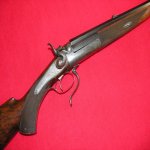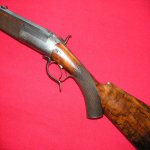A very interesting hardware-store gun
I once inspected tuna-canning factories in Thailand (a long story in itself). The fish were pressure-cooked in huge batches, cleaned, and the meat added to the cans for filling and sealing. I watched while the cans of tuna streamed through machines fitting them with paper labels. For a few minutes the machines affixed labels from a premium big-name company, then switching to generic no-name brand labels for a few more minutes, then on to another brand’s labels, filling pre-determined orders. Each can of tuna would end up being sold at vastly different price points. Each with exactly the same contents.
When one thinks of an ironmongers or hardware-store gun, it is easy to picture one of those rattle-jointed machine-churned "W. Richards" Belgian doubles that can be found on most gun-show tables. But in the mid-Victorian period, a Birmingham gun-making workshop could in one moment be building a gun destined for a respected London firm, and in the next be building a similar gun that would carry a hardware-store name. All guns were built to a pre-determined level of quality, and then it was a matter of engraving whatever name and address the contract specified. This meant that finished guns with a general merchant’s name might be just as good as those with, say, a town or city gun maker’s name. The difference would be that a gun maker would have a reputation to uphold and would be available to fix and maintain their guns, while a merchant was just in the business of selling. How does a hardware or general-goods merchant get into the gun-selling business? Family connections seems to be one way, and we’re sometimes talking about family businesses that can have long and intertwined histories.
Clement Cotterill was a merchant at No. 1, Old Square, Birmingham. He started in business as a leather seller in Edgbaston St., and was established as a hardware merchant and manufacturer by 1780. He founded the firm of Cotterill & Francis, for which the partnership was dissolved in 1790. In 1795 he entering into partnership with Thomas Ketland of Philadelphia, USA,
‘for the collection of hardwares, buttons, buckles, and all other articles manufactured in this and the neighbouring towns, and exported to the United States of North America and elsewhere’. His sons William and Thomas successively joined the partnership, first trading as Ketland, Cotterill, & Son (until 1802), then as Clement Cotterill & Sons (until 1806), and in 1825, following his daughter Mary’s marriage to Joshua Scholefield (the Member of Parliament for Birmingham), the firm traded as Scholefield & Sons.
At an unknown date John Dent Goodman became a partner in the business, and in 1861-1862 there was a Scholefield Sons & Goodman operating from Liverpool. In Birmingham the business of Scholefield, Goodman and Son, merchants, operated from 5 Minories, and in 1877-1878 the business moved to 135 Edmund street. At some point the business expanded to 31, Great St. Helens, London. The original Scholefield business may have traded in guns as part of their hardware business, but the involvement of J D Goodman was to link the company to the gun trade. Goodman was the Chairman of the Birmingham Small-Arms Trade Association (formed in 1854 by Goodman, John Field Swinburn, Isaac Hollis, Thomas Turner, Joseph Bourne, Thomas Wilson, John Rock Cooper, William Tranter, Charles Playfair, Benjamin and Henry Woodward, and others).
In 1861 the members of the association decided to establish the Birmingham Small Arms and Metal Company Ltd. (B.S.A.), in order to produce arms by machinery and thereby compete with the operations at Enfield. Goodman was elected Chairman of the Board of BSA in 1863, a position he held until 1900. Goodman was personally involved in all the trade contracts with the US government over provisions of arms in the period of the Civil War, and Scholefield, Goodman and Son was one of the companies involved in the shipping of Enfield-pattern guns to the US. It was also Goodman that secured for BSA the contract to convert 100,000 Pattern 1853 Enfields using the Snider action – think of that the next time you pick one up. Goodman was also in partnership with Joseph Rock Cooper & Co. of pepperbox pistol fame (CLARIFICATION: Cooper & Goodman, Gun and Pistol Maker, Birmingham 1857-1886/87).
In 1856 Goodman became chairman of the Birmingham Proof House, then in 1867 Abingdon Works was formed, a manufacturing partnership located in Shadwell Street to supply the trade with ready-made guns and gun parts. The partners were Goodman, Thomas Bentley, William Bourne, Charles Cooper, Charles Pryse, Richard Redman, Joseph Smith, Charles Playfair, Joseph Wilson, John Field Swinburn and Fred and Henry Woodward. But, despite Goodman’s widespread involvement in the gun trade and being a partner in several companies that made and/or sold guns, his name never appeared on any of them (CORRECTION: Goodman's name appeared on guns by Cooper & Goodman).
Today’s gun is a 12-bore double-bite screw grip rotary under-lever pinfire sporting gun of typical form, retailed by Scholefield, Goodman & Sons of Birmingham. It has no serial number, and I estimate it was made around 1867. The 29 13/16” damascus barrels have Birmingham proofs, and the top rib is signed
“Scholefield London” (the ‘London’ reference might be false advertising, but at some point the company did have a London address). There is a gun/barrel maker’s mark
“J.W” on the barrels and between the barrel lugs, and I believe this gun was built by Joseph Wilson of 67 1/2 Great Charles Street, Birmingham, one of the Abington Works partner gun makers. The gun has an elongated top strap, thin percussion fences, back-action locks signed
“Scholefield”, and about 30% coverage of foliate scroll engraving. This was a medium-quality gun that was produced by the Birmingham gun trade, but it was nevertheless built by craftsmen. What is unusual about this piece is its condition – there is still blueing visible on the trigger guard bow, case-colour on the fore-end iron, crisp engraving and chequering, and original browned barrels. Though this gun did not see much use, the bores were neglected and are now pitted. The gun weighs 7 lb 2 oz.
I believe this gun was made by Joseph Wilson, either supplying sporting guns to Scholefield, Goodman & Sons directly, or through the Abington Works. Again through a direct interest by John Dent Goodman, Scholefield, Goodman & Sons supplied Scholefield-marked rifles to the Newfoundland sealing trade (many of which are single-shot Field’s Patent side-lever in .450 caliber). Apparently Goodman visited Newfoundland several times, perhaps seeking out new business opportunities. A few Scholefield-marked shotguns are known, but to my knowledge this is the only pinfire game gun so marked. The Newfoundland trade connection might help explain how a Scholefield-marked gun ended up in Canada, but it certainly doesn’t explain how it remained in such good condition.
John Dent Goodman
William Scholefield










































































































